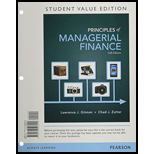
To determine: The percentage of drop in the F Company’s shares in its first year as a public company.
Answer to Problem 1OR
The percentage of drop in the F Company’s shares in its first year as a public company is 31.58%.
Explanation of Solution
Given information:
F Company has sold its share at a price of $38 each in its IPO. The price of same stock after one year was $26.
The formula to compute the percentage fall in the shares price is as follows:
Compute the percentage fall in the shares price:
Hence, the percentage fall in share price is 31.58%.
To determine: The total value of F Company’s stock immediately after the IPO and even after one year.
Introduction:
The private companies offer their stock for the first time to the public and this offering is termed as the initial public offerings (IPO). The private company that desire to become a publicly traded company usually offers the IPO.
Answer to Problem 1OR
The total value of F Company’s stock immediately after the IPO is $16,834 million.
The total value of F Company’s stock one year after IPO is $11,518 million.
Explanation of Solution
Given information:
F Company has sold its share at a price of $38 each in its IPO. The price of same stock after one year was $26. The Person MZ owner of the F Company owned 443 million shares after the IPO.
The formula to compute the total value of stock immediately after the IPO is as follows:
The formula to compute the total value of stock one year after the IPO is as follows:
Compute the total value of stock immediately after the IPO:
Hence, the total value of stock immediately after the IPO is $16,834 million.
Compute the total value of stock one year after the IPO:
Hence, the total value of stock one year after the IPO is $11,518 million.
To determine: The total personal loss of Person MZ over the year.
Answer to Problem 1OR
The total personal loss of Person MZ over the year is $5,316 million.
Explanation of Solution
Given information:
F Company has sold its share at a price of $38 each in its IPO. The price of same stock after one year was $26. The Person MZ owner of the F Company owned 443 million shares after the IPO.
The formula to compute the total personal loss over the year after the IPO is as follows:
Compute the total personal loss over the year after the IPO:
Hence, the total personal loss of Person MZ over the year is $5,316 million.
Want to see more full solutions like this?
Chapter 1 Solutions
Principles of Managerial Finance, Student Value Edition Plus NEW MyLab Finance with Pearson eText -- Access Card Package (14th Edition)
 Essentials Of InvestmentsFinanceISBN:9781260013924Author:Bodie, Zvi, Kane, Alex, MARCUS, Alan J.Publisher:Mcgraw-hill Education,
Essentials Of InvestmentsFinanceISBN:9781260013924Author:Bodie, Zvi, Kane, Alex, MARCUS, Alan J.Publisher:Mcgraw-hill Education,

 Foundations Of FinanceFinanceISBN:9780134897264Author:KEOWN, Arthur J., Martin, John D., PETTY, J. WilliamPublisher:Pearson,
Foundations Of FinanceFinanceISBN:9780134897264Author:KEOWN, Arthur J., Martin, John D., PETTY, J. WilliamPublisher:Pearson, Fundamentals of Financial Management (MindTap Cou...FinanceISBN:9781337395250Author:Eugene F. Brigham, Joel F. HoustonPublisher:Cengage Learning
Fundamentals of Financial Management (MindTap Cou...FinanceISBN:9781337395250Author:Eugene F. Brigham, Joel F. HoustonPublisher:Cengage Learning Corporate Finance (The Mcgraw-hill/Irwin Series i...FinanceISBN:9780077861759Author:Stephen A. Ross Franco Modigliani Professor of Financial Economics Professor, Randolph W Westerfield Robert R. Dockson Deans Chair in Bus. Admin., Jeffrey Jaffe, Bradford D Jordan ProfessorPublisher:McGraw-Hill Education
Corporate Finance (The Mcgraw-hill/Irwin Series i...FinanceISBN:9780077861759Author:Stephen A. Ross Franco Modigliani Professor of Financial Economics Professor, Randolph W Westerfield Robert R. Dockson Deans Chair in Bus. Admin., Jeffrey Jaffe, Bradford D Jordan ProfessorPublisher:McGraw-Hill Education





